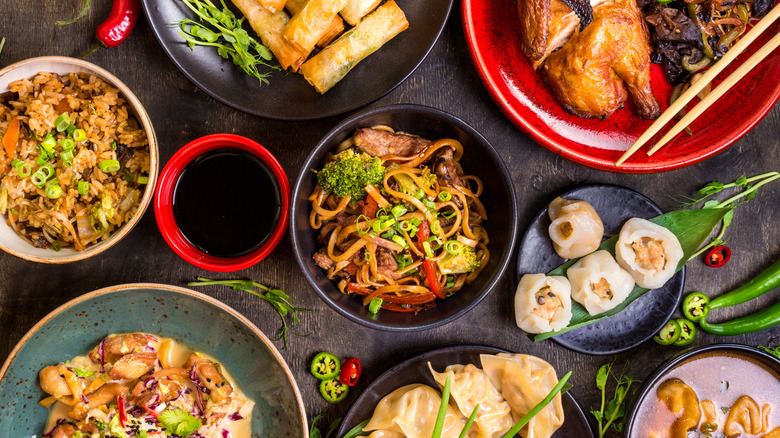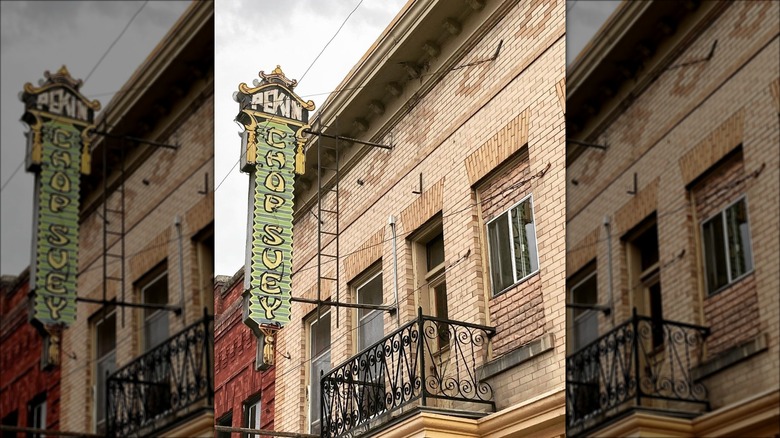The Oldest Chinese Restaurant In The US Is Nestled In A Small Town In Montana
Conjur an image of the oldest Chinese restaurant in the United States. You're picturing a classic Chinatown setting, right? Maybe in San Francisco or New York. (Indeed, San Francisco has many great Chinese restaurants to choose from.) Narrow alleys lined by gilded storefronts. Strings of festive red lanterns dangling over a bustling streetscape. Stepping through a comparatively unassuming doorway. Climbing a staircase and entering an ornate dining room done up in bright red and glistening gold. Surprise. That image, so ingrained in our collective consciousness, is oh so wrong.
Instead, the oldest Chinese restaurant in the United States is located in Butte, Montana. The one-time mining boom town is situated atop the Continental Divide about 200 miles south of the Canadian border. In other words, it's about as far from a traditional Chinatown as you can get. Established in 1911 by Tam Kwong Yee and his business partner, Hum Yow – both first-generation Chinese-Americans – Pekin Noodle Parlor occupies a nondescript brick building on the only remaining block of what was once a bustling Chinatown.
A thriving center of commerce in its heyday, the downtown district was home to a vibrant Chinese community. Laundries, mercantiles, and, of course, restaurants lined its busy alleyways. Yee and Yow, who had been operating a noodle parlor a few blocks away, moved to the current Main Street location shortly after the building opened. They subsequently established Pekin Noodle Parlor on the second floor and opened a Chinese herbal medicine shop at street level. It's unclear why, but in a bit of a twist, the restaurant's sign reads "Pekin Chop Suey."
There's more than meets the eye at Pekin Noodle Parlor
Tam Kwong Yee's great-nephew, Danny Wong, bought the business in the 1950s. In 2020, Wong's youngest son, Jerry Tam, took the helm and you can still dine at the historic restaurant today. Tam, who grew up in the business, has plenty of colorful stories to share. In 2021, he told The New York Times about his father's creative way of handling patrons who tried to skip out before paying for their Chinese dishes.
To discourage dine-and-dash antics, Wong instructed his staff to bolt the front door at the first sound of quick footsteps rattling the floorboards. Facing a no-way-out dead end at the bottom of the stairs, the runners had to turn back in search of another escape route. At the top of the staircase, Wong was waiting for them — brandishing a bayonet. He presented a choice: Pay up or wash dishes. "We called it Pekin Jail," Tam told The New York Times.
There's also the matter of the 2023 James Beard Classics Award-winning establishment's somewhat unseemly past. Rumors abound about the restaurant's closed-curtain private dining booths. (It was an Old West mining town, so you can use your imagination, here.) Tam steadfastly assures patrons that the most popular seats in the house were never intended for illicit liaisons. Enclosed seating is apparently an Asian tradition. And then there's the all-but-abandoned basement, a time capsule of long-gone days when Tam Kwong Yee operated a not-so-secret illegal gambling parlor on the premises. The oldest Chinese restaurant in the United States may not be exactly what you'd imagine, but it sure has an interesting story to tell.

